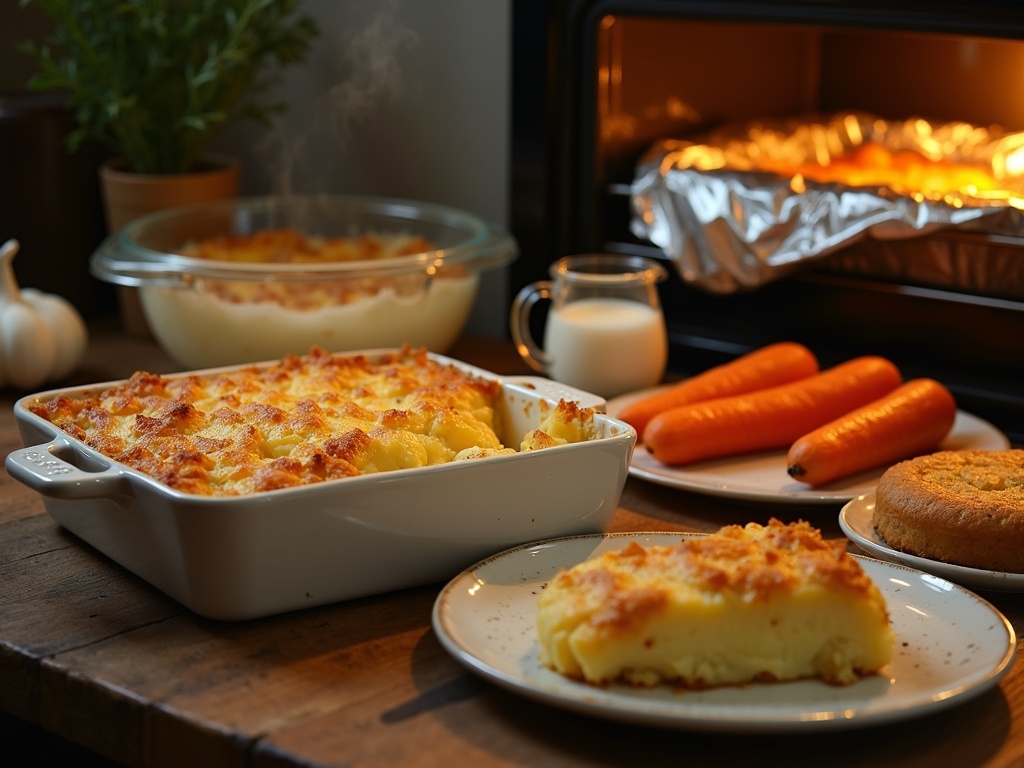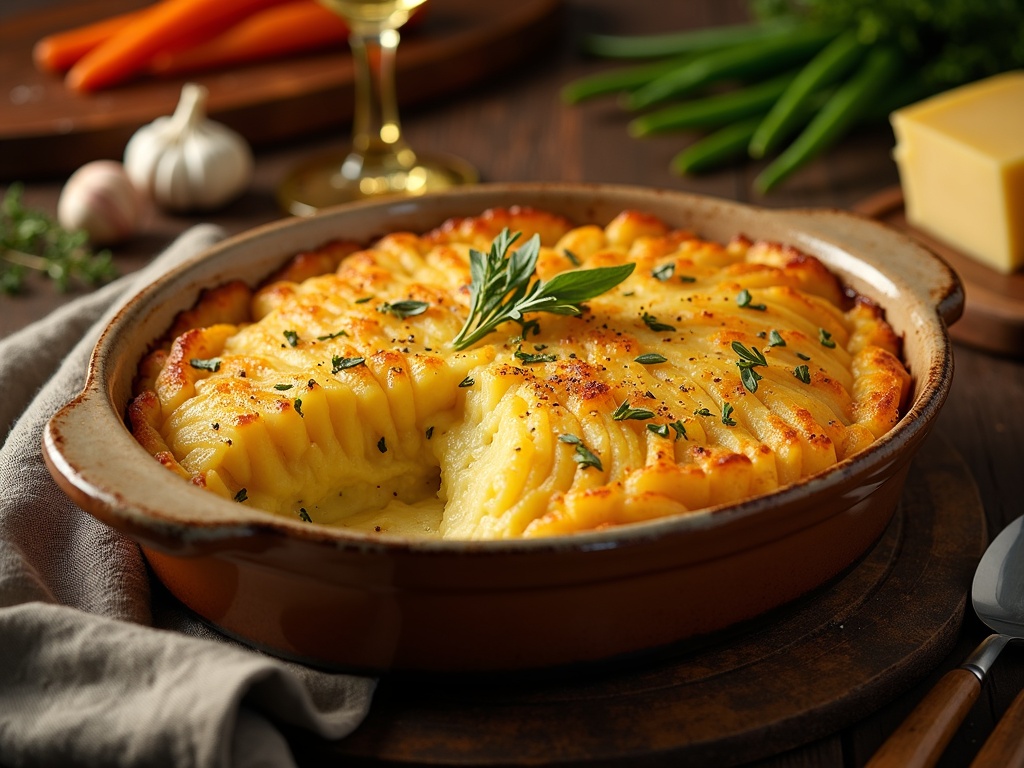Dauphinoise potatoes represent a beloved French culinary tradition featuring thinly sliced potatoes slowly baked in cream to create a dish with a golden crust and meltingly soft interior.
This classic side dish from the Dauphiné region transforms simple ingredients into an elegant accompaniment through careful layering and precise cooking techniques that allow the potatoes to develop a naturally thickened, silky sauce.
Table of Contents
Key Takeaways
- Traditional dauphinoise starts with raw potato slices cooked in cream, distinguishing it from scalloped potatoes or potato gratin that use pre-boiled potatoes or flour-based sauces.
- For best results, potatoes should be sliced uniformly thin (about 1/8 inch) using a mandoline, then layered carefully with proper seasoning between each layer.
- Starchy potatoes like Russets or Maris Piper work best as they break down slightly during cooking, contributing to the signature creamy texture.
- The dish actually improves when prepared in advance, up to 24 hours ahead of time, allowing flavors to develop more fully as the cream infuses into the potatoes.
- Dauphinoise potatoes pair excellently with roasted meats and can be stored in the refrigerator for up to three days, reheating best in the oven covered with a splash of cream.
What Makes Dauphinoise Potatoes Special
Dauphinoise potatoes stand as one of the most celebrated French side dishes, originating from the Dauphiné region in southeast France. This dish transforms simple ingredients into something truly extraordinary – layers of thinly sliced potatoes bathed in cream and baked to perfection. The result? A dish with a golden crust and a soft, almost melting interior that pairs beautifully with French-inspired main courses or stands proudly on its own.
The Authentic Preparation
What sets dauphinoise potatoes apart from other potato dishes is the specific technique and ingredients used. Unlike scalloped potatoes that often include a flour-based sauce, or potato gratin that typically uses pre-boiled potatoes and cheese, dauphinoise starts with raw potatoes. These thin slices cook slowly in cream, allowing them to absorb the rich flavor while maintaining their structure.
The authentic preparation includes:
- Thinly sliced raw potatoes (ideally waxy varieties that hold their shape)
- Heavy cream and sometimes milk for richness
- Fresh garlic, infused into the cream
- Nutmeg as a subtle aromatic element
- Salt and pepper for seasoning
- No cheese in traditional versions (though modern variations might include Gruyère)
The magic happens during baking, when the starches in the raw potatoes release and combine with the cream to create a naturally thickened, silky sauce. This process gives dauphinoise its distinctive texture that sets it apart from other potato side dishes.
The Sensory Experience
The flavor profile of dauphinoise potatoes creates a sophisticated sensory experience that makes this dish special. When you cut through the crisp golden surface, you reveal perfectly tender layers of potato suspended in a velvety cream sauce.
The taste is a careful balance of flavors – the natural sweetness of fresh cream, the savory notes from the potatoes, and the aromatic warmth from garlic and nutmeg. Each bite offers contrasting textures: the slight resistance of the potato giving way to creamy softness.
I’ve found that dauphinoise potatoes develop an almost deeper, more complex flavor when prepared a day ahead and reheated, making them perfect for entertaining. The way the flavors meld and intensify overnight creates an even more satisfying dish.
The versatility of dauphinoise potatoes also contributes to their special status in French cuisine. While traditionally served alongside roasted meats, particularly lamb or beef, they’re equally at home next to a simple green salad for a lighter meal. Their elegant presentation makes them suitable for both casual family dinners and sophisticated dinner parties.
For home cooks looking to create something special, dauphinoise potatoes offer the perfect balance of impressive results with straightforward preparation. The key lies not in complicated techniques but in attention to detail – thinly slicing the potatoes to ensure even cooking, properly seasoning each layer, and allowing sufficient time for slow baking.
This classic French dish reminds us that cooking with patience and quality ingredients often yields the most memorable results. The humble potato, when treated with respect and paired with cream in this traditional method, transforms into something truly special that continues to delight diners centuries after its creation in the French Alps.
Everything You Need
To make perfectly creamy dauphinoise potatoes, I’ve found that having the right ingredients makes all the difference. These luxurious, layered potatoes are a French classic that pairs beautifully with roasted meats or can stand alone as a satisfying vegetarian main when served with a simple salad. Let’s go through everything you’ll need to create this indulgent dish.
Essential Ingredients
- Heavy cream forms the rich base of traditional dauphinoise potatoes. I recommend using full-fat heavy cream (36–40% fat) for the most luxurious texture and flavor. For a slightly lighter version, whole milk can be combined with the cream in equal parts without sacrificing too much richness.
- Garlic cloves infuse the cream mixture with their aromatic flavor. I typically use 2–3 cloves for a subtle garlic presence throughout the dish. For those who love garlic, feel free to add more or even rub the baking dish with a cut clove before greasing.
- The potatoes themselves are crucial to getting this dish right. Russet potatoes work wonderfully because of their starch content, which helps thicken the cream sauce. Yukon Gold potatoes are my personal favorite as they hold their shape better while still releasing enough starch for a creamy sauce. Whatever variety you choose, aim for potatoes of similar size for even cooking.
- A generous amount of Gruyère cheese adds a nutty, complex flavor that complements the creamy potatoes perfectly. This Swiss cheese melts beautifully and creates that desirable golden crust on top. If Gruyère isn’t available, Emmental or even a good quality cheddar can work as alternatives.
- Fresh herbs elevate the dish from good to exceptional. Fresh thyme sprigs add an earthy, slightly floral note that cuts through the richness. I strip the leaves from the stems and sprinkle them between the potato layers for consistent flavor throughout.
- A tiny pinch of freshly grated nutmeg might seem optional, but it’s actually a traditional component that adds remarkable depth. The key is to use just enough to enhance the other flavors without making the nutmeg noticeable on its own.
- Proper seasoning is essential – I use sea salt and freshly ground black pepper generously. The potatoes absorb a lot of salt, so don’t be shy with it. Layer the seasoning between potatoes rather than just on top for balanced flavor in every bite.
- Finally, butter for greasing your baking dish prevents sticking and adds another layer of richness. I prefer unsalted butter so I can control the overall salt level in the dish.
For an extra special occasion, you might consider adding a splash of white wine to the cream mixture, similar to how it’s used in a French onion-inspired dish for added depth.
When serving, these potatoes pair beautifully with honey roasted carrots for a colorful, complementary side dish.
The best dauphinoise potatoes come from taking your time with the preparation:
- Slice the potatoes thinly and uniformly (about 1/8 inch thick) – a mandoline is helpful but not essential.
- Layer the potatoes carefully, seasoning and adding herbs and cheese between layers.
- Allow the dish to rest for 5–10 minutes after baking for the sauce to set slightly, making it easier to serve those perfect squares of potato goodness.
Creating The Perfect Layers
The secret to exceptional dauphinoise potatoes lies in the careful construction of layers. This classic French dish transforms simple ingredients into something extraordinary through proper technique and attention to detail.
Preparation and Assembly
I start by preheating my oven to 375°F to ensure it’s at the perfect temperature when my dish is ready for baking. The foundation of outstanding dauphinoise is uniform potato slices. Using a sharp knife or mandoline, I slice the potatoes to about 1/8 inch thickness—thin enough to cook evenly but thick enough to maintain their structure.
Next comes the aromatic cream mixture that will infuse the potatoes with rich flavor. I combine heavy cream and whole milk in a saucepan with a couple of crushed garlic cloves, then gently warm this mixture until it’s hot but not boiling. This pre-warming step is crucial as it helps the potatoes cook more evenly and absorb flavor.
The layering process requires patience but pays off tremendously. Here’s my tried-and-true method for building perfect dauphinoise:
- Begin with a thin layer of the warm cream mixture at the bottom of a buttered baking dish
- Arrange potato slices in an overlapping pattern, creating a complete layer
- Sprinkle with a bit of gruyère or comté cheese and season with salt and pepper
- Pour a small amount of the cream mixture over the potatoes
- Repeat these layers until all potatoes are used, finishing with cheese and the remaining cream
After assembly, I cover the dish tightly with foil. This initial covered baking period allows the potatoes to steam and become tender without over-browning the top. After about 45 minutes, I remove the foil to allow the top to develop a beautiful golden crust during the final 15–20 minutes of baking.
Looking for more potato inspiration? My Yorkshire pudding recipe makes a perfect accompaniment, or try pairing your dauphinoise with honey roasted carrots for a complete meal.
The finished dish should have tender potato layers throughout, with each slice holding its shape when served. The top will be beautifully golden and slightly crisp, while the interior remains creamy and indulgent—the hallmark of perfect dauphinoise potatoes.
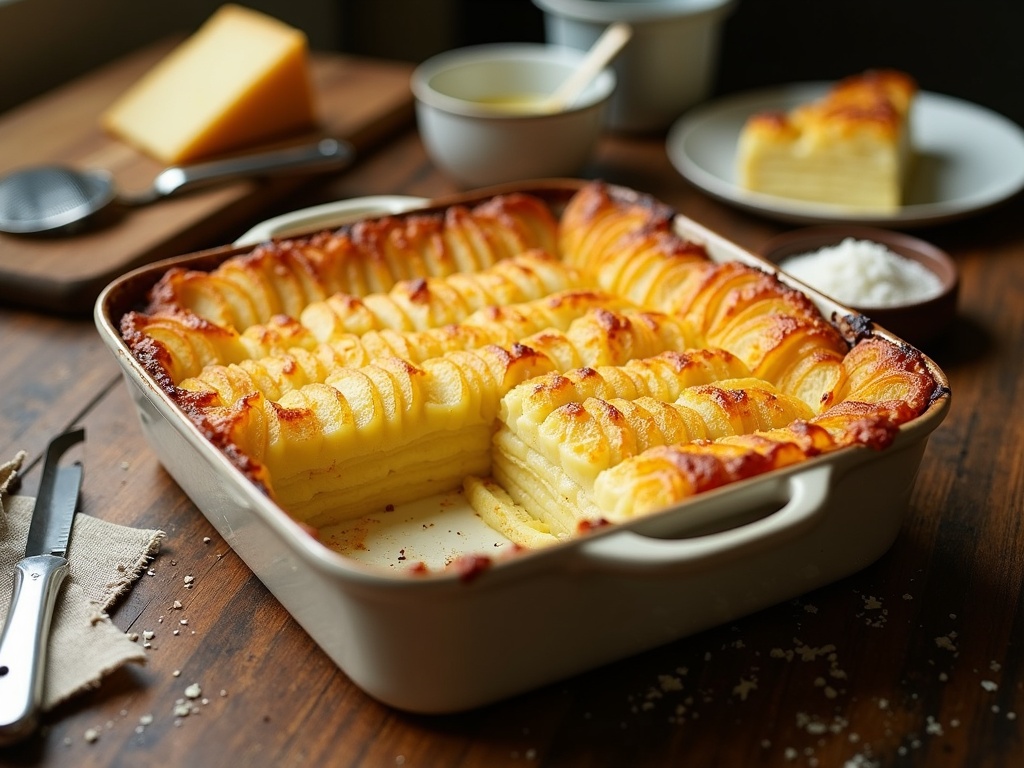
Common Mistakes To Avoid
While making dauphinoise potatoes might seem simple, there are several pitfalls that can turn this luxurious side dish into a disappointing experience. I’ve spotted these common errors in my years of perfecting this classic French dish.
Recipe Execution Errors
Using pre-grated cheese is perhaps the most tempting shortcut, but it’s a significant misstep. Pre-grated cheese contains anti-caking agents that prevent it from melting properly, resulting in a grainy texture instead of that creamy, smooth consistency that makes traditional side dishes like dauphinoise so special.
Cutting potatoes too thick is another frequent mistake. Thick slices won’t cook evenly and will likely remain firm in the center while the edges become mushy. For perfect dauphinoise, I aim for uniformly thin slices (about 1/8 inch) – a mandoline makes this task much easier and more precise.
Many cooks underestimate the importance of the resting period. Allowing your dauphinoise to rest for at least 10–15 minutes after baking helps the layers set and flavors meld together. Cutting into it too soon results in a soupy dish rather than those beautiful, defined layers that make French-inspired recipes so visually appealing.
Proper seasoning is often overlooked but crucial. I’ve learned to season between layers rather than just on top. This ensures flavor throughout the dish rather than concentrated pockets of salt and pepper. Remember that potatoes absorb a lot of seasoning, so be generous but thoughtful with your salt.
Perhaps the most fundamental mistake is using the wrong potato variety. Starchy potatoes like Russets or Maris Piper work best as they break down slightly during cooking, contributing to that creamy texture that pairs perfectly with honey roasted carrots or other roasted vegetables. Waxy potatoes hold their shape too well and won’t absorb the cream properly.
These key mistakes can be easily avoided with a bit of attention to detail:
- Use freshly grated cheese for better melting
- Slice potatoes to uniform 1/8 inch thickness
- Allow 10–15 minutes resting time after baking
- Season each layer individually
- Choose starchy potato varieties like Russets
Avoiding these common pitfalls will transform your dauphinoise from good to exceptional, creating a dish that’s worthy of both family dinners and special occasions. The extra care pays off in the rich, velvety texture and complex flavor that makes this classic comfort food so enduringly popular.
Pro Tips For Success
Creating perfect dauphinoise potatoes doesn’t need to be intimidating. I’ve found that a few simple techniques make all the difference between good and great results. After years of perfecting this classic French dish, I’ve gathered some game-changing tips that’ll elevate your next potato creation.
Essential Techniques for Perfect Dauphinoise
A mandoline is your secret weapon for dauphinoise potatoes. This simple tool creates paper-thin, consistent slices that cook evenly and create those beautiful, defined layers. While you can use a sharp knife, a mandoline delivers professional results in half the time. If you’re making mini quiches or appetizers alongside your dauphinoise, this tool will prove doubly useful.
Moisture is the enemy of crispy, golden potatoes. After slicing, I always pat my potatoes thoroughly dry with kitchen paper before layering them in the dish. This small step prevents excess water from diluting your cream mixture and ensures proper browning.
Temperature matters more than you might think. Using room temperature ingredients, especially the cream and milk, helps everything cook more evenly. I take my dairy products out about 30 minutes before starting. This simple prep step pairs nicely with other make-ahead dishes like honey roasted carrots that can share oven space.
Determining exactly when dauphinoise potatoes are done can be tricky. The most reliable test I’ve found is inserting a knife into the center – it should slide through the layers with barely any resistance, but the potatoes shouldn’t be falling apart. This careful balance is what gives dauphinoise its signature texture.
Patience delivers rewards with this dish. After removing your dauphinoise from the oven, let it rest for 15–20 minutes before serving. This resting period allows the layers to set and the flavors to deepen. I’ve found this makes cutting neat portions much easier and prevents a sloppy presentation. While waiting, you can prepare a complementary dish like Yorkshire pudding to complete your meal.
For extra flavor, I sometimes add a light grating of nutmeg between layers or infuse the cream with a bay leaf and garlic before straining. These subtle additions complement the potatoes without overwhelming their natural flavor.
Cheese selection can transform your dauphinoise. Gruyère offers the traditional nutty flavor, but I’ve achieved amazing results mixing it with a sharp cheddar or even a touch of Parmesan for the top layer. This creates a more complex flavor profile that pairs beautifully with French onion meatloaf or other savory mains.
Don’t skimp on the pan preparation. Rubbing the dish with a cut garlic clove, then buttering it well prevents sticking and adds another layer of flavor. This careful preparation means your beautiful layers will release cleanly when serving.
For the creamiest result, press down gently on the potato layers with a spatula before baking. This helps submerge the potatoes in the cream mixture and eliminates air pockets that might prevent even cooking.
Pay attention to your salt levels throughout the process. I season between layers rather than just on top, ensuring flavor throughout. This distributes the seasoning more evenly than simply salting the cream mixture.
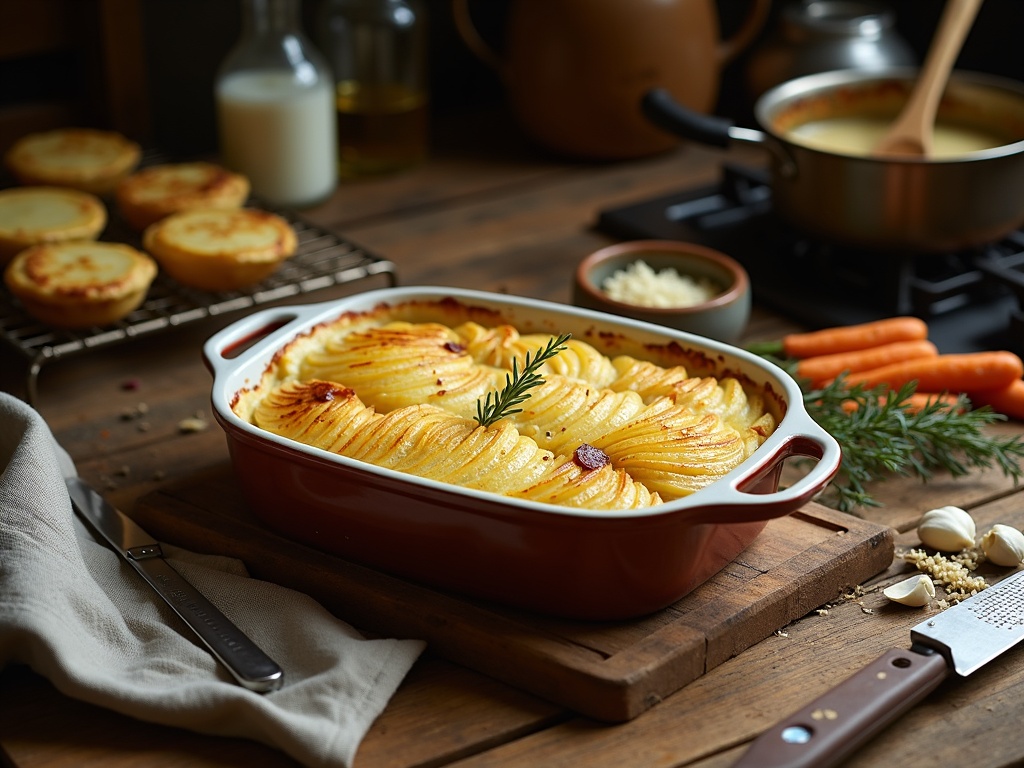
Make-Ahead Options
Dauphinoise potatoes offer perfect make-ahead convenience for busy hosts. I’ve found that preparing this dish in advance not only saves time but actually enhances the flavors as the cream mixture gets more time to infuse into the potatoes.
Advanced Preparation Tips
You can prepare your dauphinoise potatoes up to 24 hours before your meal. After assembling all ingredients in your baking dish, simply cover it tightly with plastic wrap or aluminum foil. The tight seal prevents the top layer from drying out and keeps the flavors locked in. I store mine in the refrigerator until I’m ready to cook, which gives the garlic and herbs plenty of time to permeate the potato slices.
For the best results when cooking pre-prepared dauphinoise, remember these key points:
- Remove the dish from the refrigerator at least 30–45 minutes before baking to bring it to room temperature
- This helps ensure even cooking and reduces overall baking time
- Keep the cover on during the first half of baking to prevent excessive browning
- Remove the cover for the final cooking period to achieve that signature golden crust
If you’ve already cooked your potato side dish completely, don’t worry – it reheats beautifully. Cover with foil and warm in a 325°F (165°C) oven for about 20 minutes, or until heated through. The gentle reheating prevents the cream from separating while maintaining that luscious texture.
For dinner parties, I often prepare individual portions in ramekins the day before. This approach not only creates an elegant presentation but also reduces reheating time significantly. The smaller portions need just 15 minutes to warm through.
When planning to serve reheated dauphinoise, consider adding a fresh element like chopped chives or parsley just before serving to brighten up the dish and give it that fresh-made appearance. This simple touch can transform a make-ahead convenience into what appears to be a just-prepared culinary creation.
Serving Suggestions
Dauphinoise potatoes add a touch of elegance to any meal with their creamy texture and rich flavor. I’ve found these potatoes to be incredibly versatile when it comes to pairing them with other dishes, making them perfect for both everyday dinners and special occasions.
Complementary Main Dishes
Dauphinoise potatoes shine brightest when served alongside roasted meats. The rich, creamy texture of the potatoes creates a perfect contrast to the savory depth of a good roast. Here are some exceptional pairings:
- Roast beef or steak – the creamy potatoes balance the robust flavors of red meat
- Roast lamb – the herbs in the potatoes complement the distinct flavor of lamb
- Roast chicken – creates a classic, comforting Sunday lunch combination
- Ham or gammon – the saltiness of the meat works beautifully with the creamy potato dish
- Salmon fillets – for a lighter option that still feels special
When planning a dinner party or holiday meal, dauphinoise potatoes make an impressive side dish that’s sure to impress your guests. They’re particularly good for Christmas dinner or Easter lunch as an alternative to regular roast potatoes. Their elegant presentation makes them a standout on any dinner table next to mini quiches or other appetizers for a complete feast.
Creating a Complete Meal
For a balanced meal, I’ve discovered that dauphinoise potatoes pair wonderfully with green vegetables. The light, fresh flavors of greens cut through the richness of the potatoes, creating a well-rounded plate.
When serving dauphinoise potatoes, I always consider temperature carefully. They’re actually at their best served warm rather than piping hot. This allows the flavors to develop fully and prevents burning your mouth on the molten cream. I typically let them rest for about 5–10 minutes after taking them out of the oven before serving.
A standard dauphinoise potato recipe typically serves 6–8 people, making it perfect for family gatherings or dinner parties. If you’re cooking for a smaller group, you can easily halve the recipe, but I’d suggest making the full amount anyway — the leftovers are delicious reheated the next day, perhaps alongside a simple salad for lunch.
For a truly spectacular meal, consider serving your dauphinoise potatoes with honey roasted carrots and steamed green beans. The sweetness of the carrots provides a lovely contrast to the savory potatoes. You might also add a light side salad with a vinaigrette dressing to cut through the richness.
For special occasions, transform your dauphinoise from a side dish to a centerpiece by turning it into a main course gratin. Add layers of sautéed mushrooms, spinach, or even thin slices of ham between the potato layers. Top with extra cheese and breadcrumbs for a golden, crunchy topping that’s impossible to resist.
Don’t forget about beverages! A glass of chilled white wine such as Chardonnay or a light red like Pinot Noir complements dauphinoise potatoes beautifully. For non-alcoholic options, a sparkling water with a twist of lemon helps cleanse the palate between bites of this rich dish.
For a grand finale to your meal featuring dauphinoise potatoes, consider a light dessert like crème caramel to continue the French-inspired theme without overwhelming your guests after such a satisfying main course.
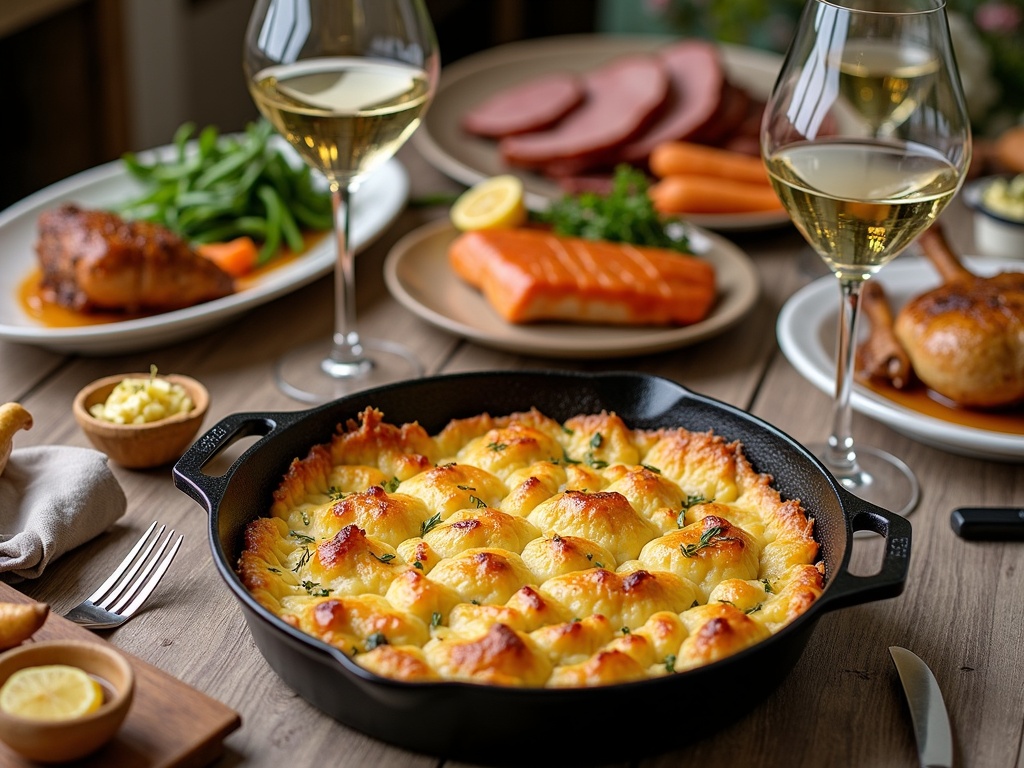
Storage And Leftovers
Properly storing dauphinoise potatoes ensures they maintain their delicious flavor and texture for future enjoyment. I’ve found that these creamy, layered potatoes actually develop even more flavor after a day in the fridge, making them perfect for preparing ahead of time.
Refrigeration Guidelines
Dauphinoise potatoes stay good in the refrigerator for up to 3 days when stored properly. After cooking, I let them cool completely before transferring to an airtight container. This prevents condensation that could make the top layer soggy. For the best results, cover the surface directly with plastic wrap before sealing the container to minimize air exposure.
If you’re making them for a special occasion, you can’t go wrong with preparing a Yorkshire pudding recipe alongside to create an impressive meal that can be partially prepared in advance.
Reheating For Best Results
The oven is definitely your friend when it comes to reheating dauphinoise potatoes. I preheat the oven to 350°F and place the potatoes in an oven-safe dish. Before placing them in the oven, I add a splash of cream over the top to restore moisture and creaminess that might have been lost during storage.
Reheating typically takes about 20–25 minutes, or until the potatoes reach an internal temperature of 165°F. I cover the dish with foil for the first 15 minutes to prevent the top from burning, then remove it for the final few minutes to re-crisp the surface.
While the microwave is convenient, it doesn’t do these potatoes justice. It often creates hot spots and can make the once-creamy sauce separate or the potatoes become gluey. If you absolutely must use a microwave, use a medium power setting and stir gently halfway through.
For a complete meal makeover, consider serving your reheated dauphinoise potatoes with honey roasted carrots for a colorful and flavorful contrast to the rich, creamy potatoes.
If you find yourself with an abundance of leftovers, dauphinoise potatoes can transform into a wonderful base for:
- A quick potato and ham breakfast hash
- A luxurious topping for a cottage pie instead of the usual mashed potatoes
